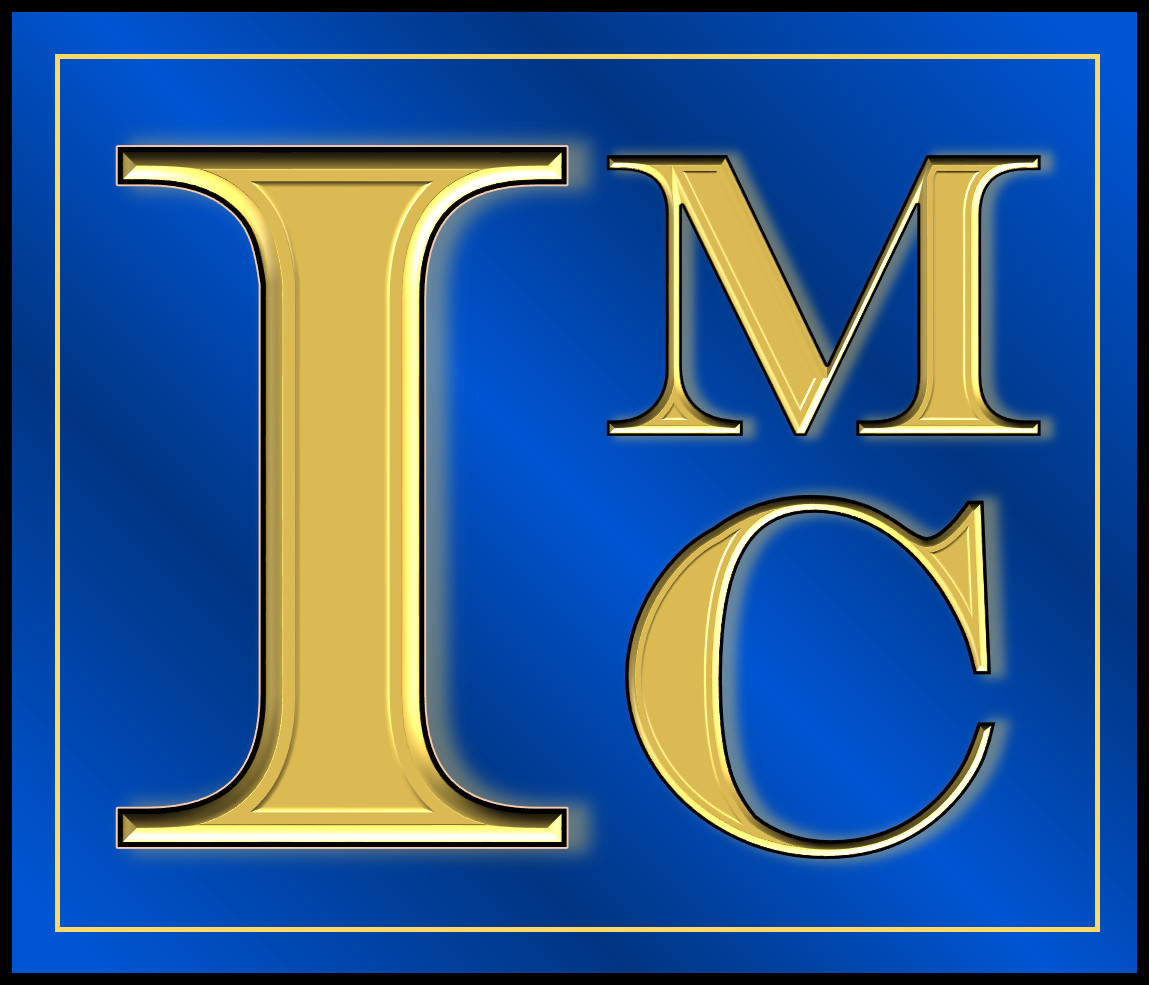
|
- 10/8 and I'm off to the Tauck French Escapade
- Step one - Kali goes to LVCC (Lafayette Veterinary Care Center) for boarding and four hours of play with her friends each day. Thankfully she loves it there.
Step two . Check in and fly through TSA with my new TSA Pre-check. What a difference!
Step three - off to the gate two hours early. I love being early.
Next stop Atlanta via a Delta commuter jet, but they had a decent first class.
- Transferred planes in Atlanta. The International Terminal was very busy. Of course, the plane is late. I'm worried about the transfer in Paris to Nice. Bet the bags don't make it. Would be the third trip in a row, Croatia, Alaska, now Nice. But I'm hoping for the best.
Electric window shades are really cool, when they work. There were several of them that did not work and were even labeled inop. So much for flying first class. No sleep for me!! Actually, I crammed an extra pillow between the window and the seat in front of me to block the sun.
Well, it turned out fine. It was dark when I wanted to sleep. The food and service was perfect. I sampled all 5 wines, which were excellent, and eve had some calvados after dinner. The little cheese biscuit snacks, Crepes Fuorrees were an incredibility tasty snack. I'm going to look for them state side.
- The transfer to my Nice airplane in Charles de Gaulle Airport was a very long walk and wore me down pretty bad. I should have taken assistance. The Hermes shop was inviting, but I was too tired to check it out.
Then the confusion set in. I couldn't find my flight number going to Nice, but I did find a flight leaving at the same time to Nice, but different flight number. Some staff said I should use this flight at Gate F3o. Others say that my flight number will board at Gate F 30. But that sign says a Flight to Bordeaux only 5 minutes before my boarding time.
So I tried to board the loading flight, Gate F33 and the check turned red. Not allowed. So back to Gate F30. Exactly at the boarding time agents showed up and the signage changed to Nice, but Good Lord, what a lot of worrying.
Best I can figure out my flight had international connecting passengers who did not clear customs in Paris and would clear customs in Nice and was therefore an international flight. The other flight had people already cleared customs and was just a domestic flight. A little explanation would have been helpful.
Air France has set new low standards for boarding, though frankly Delta wasn't much better in Atlanta. At least the food and service and wines were 5 star on all flights.
- Photos of En Route Journey
|
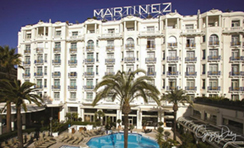
|
- 10/9, One day early arrival for the tour
- We ended up boarding on time in Paris. We taxied out to the runway and sat there for 30 minutes while the pilots decided if the technical problem, whatever that was, was serious enough to abandon the flight. They decided to give it a go and we took off.
-
Arrived Nice in the rain. Sunny day everywhere else in the world but raining in Nice and Cannes.I was very pleased to find that my bags made it to Nice on the same flight. Now that's a first.
-
The Hotel Martinez is quite famous. One of the top three in Cannes. However my room was a long, long walk from the elevators and literally on the railroad tracks with metro going by every half hour. It was a bit of a disappointment for the price of the room. The room itself is bright and cheery.
-
I was exhausted. Took a couple of naps and felt better again. I pulled a Chris Daley and reception changed my room - bigger and better location. The first room had no view of the sea, but the second room did have a sliver of a view.
-
I went to the best restaurant in Cannes, La Mome and had a fabulous meal of lamb. They use iPad's for their drink menu. Two girls next to me had Chateaubriand and it looked fabulous. Had some Cote du Chalonaise burgundy and it was very good. It was the first time I have seen herbs cut straight from a plant into the oil for bread. That was really unique.
- Photos of Hotel; Martinez and Mome's Restaurant
|
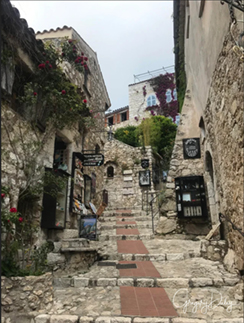
|
-
10/10 Day 1 of the tour
-
I woke up this morning and found that I can see the Mediterranean Sea from my balcony. I hired a car along with 3 other folks to see Èze and Monaco. Built on the side of a hill, Èze is particularly hard to negotiate but offers beautiful views of ancient buildings and the Riviera.
-
Èze is a seaside commune in the Alpes-Maritimes department in the Provence-Alpes-Côte d'Azur region in Southeastern France. It is located on the French Riviera, 5.2 mi to the northeast of Nice and 2.7 mi to the west of Monaco.
-
The area surrounding Èze was first populated around 200 BC as a commune situated near Mount Bastide. The earliest occurrence of the name "Èze" can be found in the maritime books of Antonin as a bay called the St. Laurent of Èze.
-
A hoard of ancient Greek silver phialae dating from the 3rd century BC was found in Èze in the late nineteenth century and is now part of the British Museum's collection. The area was subsequently occupied by not only the Romans but also the Moors, who held the area for approximately 80 years until they were driven out by William of Provence in 973.
-
By 1388 Èze fell under the jurisdiction of the House of Savoy, who built up the town as a fortified stronghold because of its proximity to Nice. The history of Èze became turbulent several times in the next few centuries as French and Turkish troops seized the village under orders from Hayreddin Barbarossa in 1543, and Louis XIV destroyed the walls surrounding the city in 1706 in the war of the Spanish succession. Finally in April 1860, Èze was designated as part of France by unanimous decision by the people of Èze.
-
Èze has been described as an "eagle's nest" because of its location overlooking a high cliff 1,401 ft above sea level on the French Mediterranean. It is so high that the light ochre church within Notre Dame de l’Assomption built in 1764 can be seen from afar. An Egyptian cross inside the church suggests the village's ancient roots, when the Phoenicians erected a temple there to honor the goddess Isis.
- Photos of Èze and the environs
|
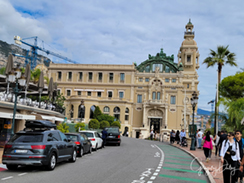
|
-
10/10, Day 1 of the tour
-
I watched the changing of the guard in Monaco. Monaco is ruled by a king. Second smallest country in the world, very rich and very clean. I saw the Cathedral of Monaco. Visited Casino Royal, but did not have my passport. Maybe tomorrow.
-
In the small world department, I met several of my sister's friends at the welcoming reception and dinner. Three ladies that are with her in the Orleans Club and one attorney that she worked with and the parents of another attorney that was an AUSDA in her husband's court. Traveling solo is less spooky than I originally thought.
-
The Principality of Monaco is a sovereign city-state on the French Riviera a few miles west of the Italian region of Liguria, on the Mediterranean Sea. It is bordered by France to the north, east and west. The principality is home to 38,682 residents, of whom 9,486 are Monégasque nationals; it is widely recognised as one of the most expensive and wealthiest places in the world. The official language of the principality is French. In addition, Monégasque (a dialect of Ligurian), Italian and English are spoken and understood by many residents. With an area of 0.81 sq mi, it is the second-smallest sovereign state in the world, after Vatican City. Its 49,230/sq mi make it the most densely-populated sovereign state in the world.
-
The principality is governed under a form of constitutional monarchy, with Prince Albert II as head of state, who wields immense political power despite his constitutional status. The prime minister, who is the head of government, can be either a Monégasque or a French citizen; the monarch consults with the Government of France before an appointment. The state's sovereignty was officially recognised by the Franco-Monégasque Treaty of 1861, with Monaco becoming a full United Nations voting member in 1993. Despite Monaco's independence and separate foreign policy, its defence is the responsibility of France. However, Monaco does maintain two small military units.
-
Economic development was spurred in the late 19th century with the opening of the state's first casino, the Monte Carlo Casino, and a railway connection to Paris.[19] Since then, Monaco's mild climate, scenery, and gambling facilities have contributed to the principality's status as a tourist destination and recreation centre for the rich. In more recent years, Monaco has become a major banking centre and has sought to diversify its economy into the services sector and small, high-value-added, non-polluting industries. Monaco is famous as a tax haven: the principality has no personal income tax and low business taxes. Over 30% of the residents are millionaires with real estate prices reaching $116,374 per square metre in 2018.
-
Monaco is not formally a part of the European Union (EU), but it participates in certain EU policies, including customs and border controls. Through its relationship with France, Monaco uses the euro as its sole currency; before, it used the Monegasque franc, which was pegged, and exchangeable with, the French franc until the 1st of January 2002.
- Video of the Monaco Harbor
- Photos of Monaco and Monte Carlo
|
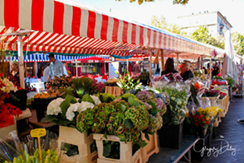
|
-
10/11, Day 2 of the tour
-
Our Tauck tour bus departed Cannes and brought us to Nice. We walked around the square and saw the fresh markets. I stopped at a small cafe near the market and had a piece of bread and a small cup of coffee. Breakfast did not agree with me.
-
Nice is the prefecture of the Alpes-Maritimes department in France. The Nice agglomeration extends far beyond the administrative city limits, with a population of nearly 1 million on an area of 287 sq mi. Located on the French Riviera, the southeastern coast of France on the Mediterranean Sea, at the foot of the French Alps, Nice is the second-largest French city on the Mediterranean coast and second-largest city in the Provence-Alpes-Côte d'Azur region after Marseille. Nice's airport serves as a gateway to the region.
-
The area of today's Nice contains Terra Amata, an archaeological site which displays evidence of a very early use of fire 380,000 years ago. Around 350 BC, Greeks of Marseille founded a permanent settlement and called it Νίκαια, Nikaia, after Nike, the goddess of victory. Through the ages, the town has changed hands many times. Its strategic location and port significantly contributed to its maritime strength.
-
The natural environment of the Nice area and its mild Mediterranean climate came to the attention of the English upper classes in the second half of the 18th century, when an increasing number of aristocratic families took to spending their winters there. In 1931, following its refurbishment the city's main seaside promenade, the Promenade des Anglais ("Walkway of the English"), was inaugurated by Prince Arthur, Duke of Connaught; it owes its name to visitors to the resort. These included Queen Victoria along with her son Edward VII who spent winters there, as well as Henry Cavendish, born in Nice, who discovered hydrogen.
-
Nice's appeal extended to the Russian upper classes. Prince Nicholas Alexandrovich, heir apparent to Imperial Russia, died in Nice and was a patron of the Russian Orthodox Cemetery, Nice where Princess Catherine Dolgorukova, morganatic wife of the Tsar Alexander II of Russia, is buried. Also buried there are General Dmitry Shcherbachev and General Nikolai Yudenich, leaders of the anti-Communist White Movement.
-
Those interred at the Cimetière du Château include celebrated jeweler Alfred Van Cleef, Emil Jellinek-Mercedes, founder of the Mercedes car company, film director Louis Feuillade, poet Agathe-Sophie Sasserno, dancer Carolina Otero, Asterix comics creator René Goscinny, The Phantom of the Opera author Gaston Leroux, French prime minister Léon Gambetta, and the first president of the International Court of Justice José Gustavo Guerrero.
-
We passed the city of Eze. It's such a picturesque city.
- Photos of Nice and the environs
|
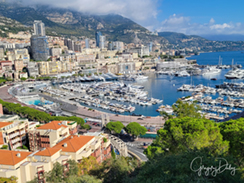
|
-
10/11, Day 2 of the tour
-
The Tauck tour bus then proceeded to Monaco. Rather than watch the changing of the guards again, I found an outdoor cafe for lunch. The plate with three chunks which look like chicken are actually very large pieces of calamari, very good calamari.
-
Visiting the Monte Carlo Casino was special. It is so elegant and charming. They must make a lot of money to maintain much less build such a structure.
-
Our bus is way too big for these small roads but our bus driver is very skilled.
- Video of the Monaco Harbor
- Photos of Monaco and the environs
|
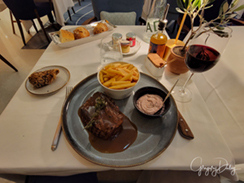
|
-
10/11, Day 2 of the tour.
-
Returned to Cannes for my last night in the Hotel Martinez.
-
Not much of a sunset from my room.
-
That evening I decided to eat in the Hotel Martinez. It was expensive but good. They convinced me that their $65 steak was smaller than their $44 hamburger. Check out the plate and you see that it was huge. The Givry red wine from cote du Beaune was excellent. Dinner in hotel was memorable and excellent but twice the price of the dinner of friends who had the same meal elsewhere.
- Photos of sunset and my meal in the hotel
|
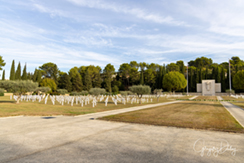
|
-
10/12, Day 3 of the tour
-
Rhone American Cemetery and Memorial is a Second World War American military war grave cemetery, located within the city of Draguignan. The cemetery, named for the Rhone river where most of those interred fought and died, was dedicated in 1956, and contains 858 American war dead and covers 12.5 acres . It is administered by the American Battle Monuments Commission.
-
Those interred died mostly in the summer of 1944 during Operation Dragoon, the Allied invasion of southern France from the Mediterranean, which followed the Allied invasion of Normandy. This operation was designed to open a second beachhead and Allied combat zone in France, threatening the Axis units confronting the Normandy combat zone, and thus to accelerate the Allied drive into Western Europe.
- Photos of the Rhone American Cemetary
|
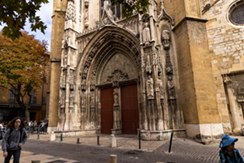
|
-
10/12, Day 3 of the tour
-
Bus and tour guide did not meet properly, so we did three times the walking we were scheduled to do. One leg downhill, one leg (the tour) uphill and the third leg downhill. We were supposed to do only one leg downhill. Everyone was exhausted.
-
Had a nice lunch in an outdoor sidewalk cafe with Harry and Andrea. Huge piece of pork with all the trimmings.
-
Aix-en-Provence is a city and commune in southern France, about 20 mi north of Marseille. A former capital of Provence, it is the subprefecture of the arrondissement of Aix-en-Provence, in the department of Bouches-du-Rhône, in the region of Provence-Alpes-Côte d'Azur. The population of Aix-en-Provence is approximately 145,000. Its inhabitants are called Aixois or, less commonly, Aquisextains.
-
Aix was founded in 123 BC by the Roman consul Sextius Calvinus, who gave his name to its springs, following the destruction of the nearby Gallic oppidum at Entremont. In 102 BC its vicinity was the scene of the Battle of Aquae Sextiae, where the Romans under Gaius Marius defeated the Ambrones and Teutones, with mass suicides among the captured women, which passed into Roman legends of Germanic heroism.
-
In the 4th century AD it became the metropolis of Narbonensis Secunda. It was occupied by the Visigoths in 477. In the succeeding century, the town was repeatedly plundered by the Franks and Lombards, and was occupied by the Saracens in 731 and by Charles Martel in 737. Aix, which during the Middle Ages was the capital of Provence, did not reach its zenith until after the 12th century, when, under the houses of Barcelona/Aragon and Anjou, it became an artistic centre and seat of learning.
-
Aix passed to the crown of France with the rest of Provence in 1487, and in 1501 Louis XII established there the parliament of Provence, which existed until 1789. In the 17th and 18th centuries, the town was the seat of the Intendance of Provence. Current archeological excavations in the Ville des Tours, a medieval suburb of Aix, have unearthed the remains of a Roman amphitheatre. A deposit of fossil bones from the Upper Continental Miocene gave rise to a Christian dragon legend.
- Photos of Aix-en-Provence and the environs
|
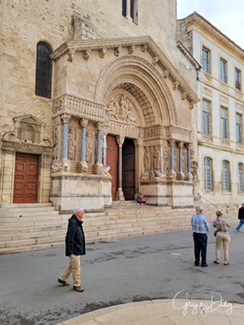
|
-
10/13, Day 4 of the tour
-
We did a walking tour through Arles.
-
Arles is a coastal city and commune in the South of France, a subprefecture in the Bouches-du-Rhône department of the Provence-Alpes-Côte d'Azur region, in the former province of Provence.
-
A large part of the Camargue, the largest wetlands in France, is located on the territory of the commune, making it the largest commune in Metropolitan France in terms of geographic territory. The city has a long history, and was of considerable importance in the Roman province of Gallia Narbonensis. The Roman and Romanesque Monuments of Arles were listed as UNESCO World Heritage Sites in 1981.
-
Many artists have lived and worked in this area because of the southern light, including Pablo Picasso, Paul Gauguin, Jacques Réattu, and Peter Brown. The Dutch post-Impressionist painter Vincent van Gogh lived in Arles from 1888 to 1889, and produced over 300 paintings and drawings during his time there. These are in internationally known museums and private collections around the world. An international photography festival has been held annually in the city since 1970.
- Photos of Arles and the environs
|
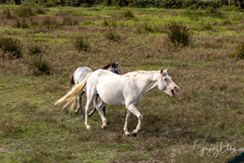
|
-
10/13, Day 4 of the tour
-
Saw the horse and bulls of the Camargue area about an hour south of Arles. There is a lot of similarity to South Louisiana, delta region, bird migration, farm lands. The bull fights here do not kill the bulls. Look them up on YouTube. They are quite fascinating. The people on the ranch were so nice.
-
Camargue is a region of France located south of Arles, between the Mediterranean Sea and the two arms of the Rhône delta. The eastern arm is called the Grand Rhône; the western one is the Petit Rhône.
-
Camargue was designated a Ramsar site as a "Wetland of International Importance" on 1 December 1986.
-
The Camargue bull is a breed of domestic cattle native to the Camargue marshlands of the river delta of the Rhône in southern France. It is used for the traditional sport of course camarguaise, a kind of bloodless bull-fight, but not for the corrida, Iberian-style bull-fighting. It is one of two cattle breeds raised in semi-feral conditions in the Camargue; the other is the Brava or Race de Combat, a fighting breed. Since 1996 it has been officially known as the Provençal: Raço di Biòu.
-
The Camargue horse is an ancient breed of horse indigenous to the Camargue area in southern France. Its origins remain relatively unknown, although it is generally considered one of the oldest breeds of horses in the world. For centuries, possibly thousands of years, these small horses have lived wild in the harsh environment of the Camargue marshes and wetlands of the Rhône delta, which covers part of the départements of Gard and Bouches-du-Rhône. There they developed the stamina, hardiness and agility for which they are known today. Traditionally, they live in semi-feral conditions in the marshy land of the region. The Camargue horse is the traditional mount of the gardians, the Camargue "cowboys" who herd the black Camargue bulls used for "courses camarguaises" in southern France. Camargue horses galloping through water is a popular and romantic image of the region.
-
When I returned to my cabin, I found little Kali in a sailboat on the waves. I love my stew!!
-
We left Arles at 1630 en route to Avignon. We passed some modern wind vanes, a nice suspension bridge, and an old castle. The riverboat cruises about 10 knots and is quite pleasant. I see why they are so popular.
- Video of our lunch at the farm in the Camargue 1
- Video of our lunch at the farm in the Camargue 2 (Peter and Pam)
- Photos a farm in the Camargue
|
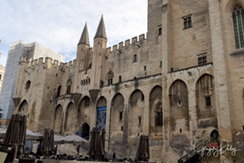
|
-
10/14, Day 5 of the tour
-
A tourist train rode us through the most interesting parts of Avignon. We saw the old double walls of the city. We saw the pope's Palace where 7seven pope's lived for 70 years. There were still popes in the Vatican. The church was split. We saw many elegant old theaters churches and city halls. We saw a very old Jesuit seminary.
-
Returned to the ship and found Little Kali hiding behind a pillow and a delta wing fighter plane armed with Q-tip missiles. Mariya Primova, my stewardess, is the best. During the trip we did see a delta wing fighter flying low in two different cities. I would guess this was part of some sort of NATO exercise.
-
Avignon is the prefecture of the Vaucluse department in the Provence-Alpes-Côte d'Azur region of Southeastern France. Located on the left bank of the river Rhône, the commune had a population of 93,671 as of the census results of 2017, with about 16,000 living in the ancient town centre enclosed by its medieval walls. It is France's 35th largest metropolitan area according to INSEE with 336,135 inhabitants (2019), and France's 13th largest urban unit with 458,828 inhabitants (2019). Its urban area was the fastest-growing in France from 1999 until 2010 with an increase of 76% of its population and an area increase of 136%. The Communauté d'agglomération du Grand Avignon, a cooperation structure of 16 communes, had 192,785 inhabitants in 2018.
-
Between 1309 and 1377, during the Avignon Papacy, seven successive popes resided in Avignon and in 1348 Pope Clement VI bought the town from Joanna I of Naples. Papal control persisted until 1791 when during the French Revolution it became part of France. The city is now the capital of the Vaucluse department and one of the few French cities to have preserved its city walls.
-
The historic centre, which includes the Palais des Papes, the cathedral and the Pont d'Avignon, became a UNESCO World Heritage Site in 1995 because of its architecture and importance during the 14th and 15th centuries. The medieval monuments and the annual Festival d'Avignon (commonly called: "Festival In d'Avignon") and its accompanying Festival Off d'Avignon - one of the world's largest festivals for performing arts, have helped to make the town a major centre for tourism.
- Photos of Avignon and the environs
|
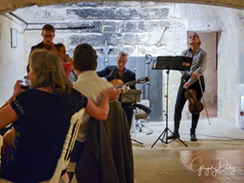
|
-
10/14, Day 5 of the tour
-
We had dinner at the Chateau Duchy D'Uzes, 45 minutes from Avignon. The Duke was not home so we ate without him. Excellent meals and wines and great entertainment by 3 musicians from Lyon
-
I only stayed out till 10 pm but little Kali got mad and ate my chocolates. I hope she doesn't get sick. My stewardess, Mariya Primova, is so creative. I ❤️ her creativity.
-
Uzès is a commune in the Gard department in the Occitanie region of Southern France. In 2017, it had a population of 8,454.
-
Originally Ucetia or Eutica in Latin, Uzès was a small Gallo-Roman administrative settlement. The town lies at the source of the Alzon river, at Fontaine d'Eure, from where a Roman aqueduct was built in the first century BC, to supply water to the local city of Nîmes, 31 miles away. The most famous stretch of the aqueduct is the Pont du Gard, now a UNESCO World Heritage Site, which carried fresh water over splendid arches across the river Gardon.
-
The title of Duke of Uzès, in the family de Crussol d'Uzès, is the premier title in the peerage of France, coming right after the princes of the blood. The title of seigneur d'Uzès is attested in a charter of 1088. After part of Languedoc was attached to royal demesne (1229), the lords' (and later dukes') military skill and fealty to the Crown propelled their rise through the nobility, until, after the treason of the last Duke of Montmorency, beheaded in 1632, the title of First Duke of France fell to Uzès, who retain their stronghold in the center of town today, which has expanded round the 11th century Tour Bermond. If France were a kingdom, it would be the job of the duke of Uzès to cry out, "Le Roi est mort. Vive le Roi!" at each state funeral, and defend the honour of the queen mother. Twenty-one dukes have been wounded or killed as hereditary Champion of France over the centuries.
- Video of trio playing at our dinner in the Duchey of Uzes
- Photos of the Duchey of Uzes and environs
|
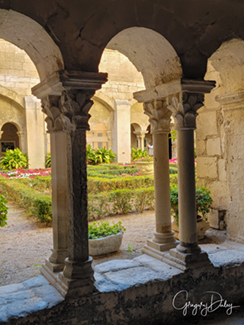
|
-
10/15, Day 6 of the tour
-
All about Vincent Van Gough. We toured the asylum the citizens of Arles had him committed. Beautiful grounds. Was originally a monastery. Not bad digs at all.
-
Arles is a coastal city and commune in the South of France, a subprefecture in the Bouches-du-Rhône department of the Provence-Alpes-Côte d'Azur region, in the former province of Provence.
-
A large part of the Camargue, the largest wetlands in France, is located on the territory of the commune, making it the largest commune in Metropolitan France in terms of geographic territory. (Maripasoula, French Guiana, is much larger than Arles). The city has a long history, and was of considerable importance in the Roman province of Gallia Narbonensis. The Roman and Romanesque Monuments of Arles were listed as UNESCO World Heritage Sites in 1981.
-
Many artists have lived and worked in this area because of the southern light, including Pablo Picasso, Paul Gauguin, Jacques Réattu, and Peter Brown. The Dutch post-Impressionist painter Vincent van Gogh lived in Arles from 1888 to 1889.
-
Vincent Willem van Gogh (30 March 1853 – 29 July 1890) was a Dutch Post-Impressionist artist who emerged as one of the most famous figures in the history of Western art after his death. In only a decade, Van Gogh created a prolific body of more than 2,000 works of art. Most of his 1,100 drawings and works on paper and nearly 900 oil paintings were produced during the last two years of his life. Van Gogh's landscapes, still lifes, portraits, and self-portraits are characterized by vibrant contrasts of complementary colors and expressive brushwork, and his abstract, linear planes were inspired by the Japanese prints Van Gogh collected and admired. His innovations contributed to the foundations of modern art. Van Gogh's images often reflect personal symbolism, experiences, and emotions he discussed in correspondence with family and friends. He expressed a desire to communicate joy and comfort through his art and aspired to gather a community of like-minded artists in southern France. Van Gogh did not achieve commercial success in his lifetime and relied on financial support from his brother, Theo van Gogh. His life was shaped by severe depression and episodes of acute psychological distress. Van Gogh committed suicide at the age of 37.
-
The son of a Dutch Reformed minister, Van Gogh was serious, quiet and thoughtful as a child. He began drawing at an early age and as a young man worked as an art dealer, often traveling, but became depressed after he was transferred to London. He turned to religion and spent time as a Protestant missionary in southern Belgium. He drifted in ill health and solitude before taking up painting in 1881, having returned home to his parents. His younger brother Theo supported him financially; the two kept a long correspondence by letter, which, when published, contributed to his growing posthumous reputation as an artist.
-
His early works, mostly still lifes and depictions of peasant laborers, contain few signs of the vivid color that distinguish his later work. In 1886, Van Gogh moved to Paris where he met members of the avant-garde, including Émile Bernard and Paul Gauguin, who were reacting against the Impressionist sensibility. As his work developed he created a new approach to still life and landscape. His paintings grew brighter as he developed a style that became fully realized during his stay in Arles in the South of France in 1888. During this period he broadened his subject matter to include series of olive trees, wheat fields and sunflowers.
-
Van Gogh's paintings did not sell during his lifetime, during which he was generally considered a madman and a failure, although some collectors recognized the value of his work. His fame came only after his death. Scholars increasingly have recognized the role of Vincent's sister-in-law Jo Bonger-Van Gogh for shaping and promoting his reputation as an artist. He evolved in the public imagination into a misunderstood genius. His reputation grew in the early 20th century as elements of his style came to be incorporated by the Fauves and German Expressionists. He attained widespread critical and commercial success over the ensuing decades, and is remembered as an important but tragic painter whose troubled personality typifies the romantic ideal of the tortured artist.
-
Today, Van Gogh's works are among the world's most expensive paintings to have ever sold, and his legacy is honored by the Van Gogh Museum established by the Dutch government in Amsterdam, which holds the world's largest collection of his paintings and drawings. They were originally held by his brother Theo and inherited by Theo's wife, Jo Bonger-Van Gogh, who shrewdly kept Vincent's best works.
- Photos of Saint-Rémy-de-Provence and the environs
|
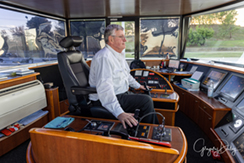
|
-
10/15. Day 6 of the tour
-
We did a tour of one of the Châteauneuf-du-Pape wineries. After the tour we tasted four of their wines. It was some of the best Châteauneuf-du-Pape wines I've ever tasted.
-
Châteauneuf-du-Pape is a commune in the Vaucluse department in the Provence-Alpes-Côte d'Azur region in Southeastern France. The village lies about 1.9 mi to the east of the Rhône and 7.5 mi north of the town of Avignon. As of 2019 the commune had a population of 2,055.
-
A ruined medieval castle sits above the village and dominates the landscape to the south. It was built in the 14th century for Pope John XXII, the second of the popes to reside in Avignon. None of the subsequent Avignon popes stayed in Châteauneuf but after the schism of 1378 the antipope Clement VII sought the security of the castle. With the departure of the popes the castle passed to the archbishop of Avignon, but it was too large and too expensive to maintain and was used as a source of stone for building work in the village. At the time of the Revolution the buildings were sold off and only the donjon was preserved. During the Second World War an attempt was made to demolish the donjon with dynamite by German soldiers but only the northern half was destroyed; the southern half remained intact.
-
Châteauneuf-du-Pape is a French wine, an Appellation d'origine contrôlée (AOC) located around the village of Châteauneuf-du-Pape in the Rhône wine region in southeastern France. It is one of the most renowned appellations of the southern part in the Rhône Valley, and its vineyards are located around Châteauneuf-du-Pape and in neighboring villages, Bédarrides, Courthézon and Sorgues, between Avignon and Orange. They cover slightly more than 7,900 acres and produce over 11,000,000 liters of wine a year, more wine made in this one area of the southern Rhône than in all of the northern Rhône.
- Photos of Châteauneuf-du-Pape and the environs
|
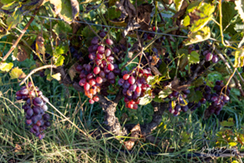
|
-
10/16, Day 7 of the tour
-
Visited a farm in Clérieux, which produces a variety of fruits. They have a great program for children to learn to plant and cook. A very down to earth experience for children in this electronic age. Sampled some of their fruit and fruit juices. Wonderful. The farm is located close to the foothills of the Alps.
- Photos of the village of Clérieux/a>
|
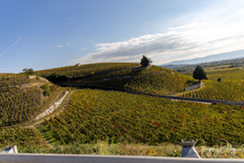
|
-
10/16, Day 7 of the tour
-
We visited the La Cite Du Chocolat - Valrhona. The chocolates were so good and there were so many to choose from.
-
Then we took a small sightseeing "train" up into the hills where the grapes are grown.The scenery from u high was beautiful.
-
We had an overnight boat passage. They tied the boat to the floating bollards of the lock a bit too tight. The boat was scraping loudly on the sides of the locks as it rose. This woke up everyone onboard.
-
Tain-l'Hermitage, commonly known as Tain, is a commune in the French department of Drôme, southeastern France.
-
It is located on the left bank of the river Rhône, opposite Tournon-sur-Rhône, which is located in Ardèche. The view from the vine-covered hill above the town has attracted many tourists including, in 1788, future American President Thomas Jefferson.
-
A notable wine producing commune, wines include Hermitage AOC and Crozes-Hermitage AOC, Cornas AOC. The red wines are produced from Syrah, and the whites from Marsanne and/or Roussanne. Tain-l'Hermitage is home to a large number of wineries, including Maison M. Chapoutier, Caves de Tain and Paul Jaboulet Âiné, as well as many smaller domaines.
-
In 1818 the commune was the home of French wine négociant Calvet, founded by Jean-Marie Calvet. Shortly after, it expanded to Bordeaux, establishing itself in the city proper and building a château in the Médoc in 1870.
- Photos of Tain-l'Hermitage and the environs
|
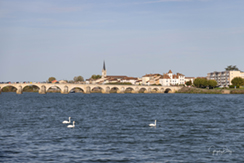
|
-
10/17, Day 8 of tour
-
This is the first time I have traveled on a Swiss flag vessel. They don't even border a sea or ocean.
-
Mâcon is a city in east-central France. It is the prefecture of the department of Saône-et-Loire in Bourgogne-Franche-Comté. Mâcon is home to near 34,000 residents, who are referred to in French as Mâconnais. The city gave its name to the nearby vineyards and wine 'appellation'.
-
The agglomeration of Mâcon originates from the establishment of an oppidum and of a river port by the Celts from the Aedui, probably at the beginning of the first century BC. Known then under the name of Matisco, the town developed significantly during the age of the Roman Empire. This is demonstrated by the large Roman hoard known as the Mâcon Treasure that was discovered in the town in 1764, the remains of which is in the British Museum. During the 4th century, the town was fortified.
-
During the Middle Ages, Mâcon was the administrative center of a county belonging to the Duchy of Burgundy at the extremity of the bridge over the Saône leading to the Bresse territory belonging to the Duchy of Savoy. The town controlled access to present-day Lamartinien Valley (Val Lamartinien), where the southern end of the Côte de Bourgogne joins the first foothills of the Beaujolais hills, opening the way to the rich plains of the Loire.
-
On 3 June 1564, Charles IX from Chalon, stopped in the town during his Royal Tour of France (1564–1566), accompanied by the Court and the nobles of his kingdom, including his brother the Duke of Anjou, Henry of Navarre, the cardinals of Bourbon and Lorraine. The town is strategically built: it was a possible entrance into the kingdom for the Swiss or German mercenaries during the French Wars of Religion. He was welcomed by the Queen Jeanne III of Navarre, nicknamed the "Queen of Protestants", and 1,500 Huguenots.
-
On 21 October 1790, the matriarch of a prominent local family gave birth to a son who remains highly visible in his hometown, the Romantic poet and historian Alphonse de Lamartine.
-
In 1790, the Revolutionary government designated Mâcon as the capital (chef-lieu) of Saône-et-Loire, a newly created département within the radical restructuring of national administration.
-
In 1814, the town was invaded by Austrian troops and then liberated twice by French troops before being permanently occupied until the fall of the Empire. After Napoléon's return and the subsequent Hundred Days, Mâcon and the Mâconnais were again captured by the Austrians.
-
During World War II, Mâcon was the northernmost town in the unoccupied zone libre between Paris and Lyon. The town was liberated on 4 September 1944 as part of Operation Dragoon by troops who had landed in Provence.
- Photos of Mâcon and the environs
|
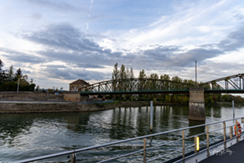
|
-
10/17, Day 8 of the tour
-
We had a beautiful cruise up the Saône River.
-
Chalon-sur-Saône lies in the south of the Bourgogne-Franche-Comté and in the east of France, approximately 34 mi north of Mâcon. It is located on the Saône river, and was once a busy port, acting as a distribution point for local wines which were sent up and down the Saône river and the Canal du Centre, opened in 1792.
-
Though the site was a capital of the Aedui and objects of La Tène culture have been retrieved from the bed of the river here, the first mention of Cavillonum is found in Commentarii de Bello Gallico. The Roman city already served as a river port and hub of road communications, of the Via Agrippa and side routes. In 354 AD the Roman Emperor Constantius II stationed the Roman 7th Army in Chalon (then called Cabyllona) for an invasion against the brother kings, Gundomadus and Vadomarius of the Alamanni. However, not having received supplies, the Roman troops revolted, and were pacified by the grand chamberlain Eusebius with money. In Late Antiquity the city had dwindled so much that a wall round it encircled fifteen hectares.
-
Saint Marcellus of Chalons (Saint Marcel) is said to have been martyred here in 179 AD. Chalon became one of the de facto capitals of the kingdom of Burgundy under Guntram, king from 561 to 592, who died here. Guntram also promoted the cult of Saint Marcellus. It continued to pay for its importance by being frequently attacked until the 10th century. The bishopric of Chalon-sur-Saône, a suffragan of the Archdiocese of Lyon, was also established here in the 6th century, and a Church Council was held here from 644–655. After the French Revolution, in accordance with the Concordat of 1801, the diocese of Chalon was amalgamated with the diocese of Autun, which gave the name to the new entity.
- Photos of Chalon-sur-Saône and the environs
|
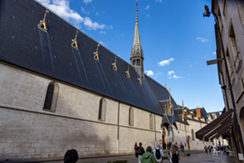
|
-
10/18, Day 9 of tour
-
Beaune is the wine capital of Burgundy in the Côte d'Or department in eastern France. It is located between Lyon and Dijon. Beaune is one of the key wine centers in France, and the center of Burgundy wine production and business. The annual wine auction of the Hospices de Beaune is the primary wine auction in France.
-
The town is surrounded by some of the world's most famous wine villages, while the facilities and cellars of many producers, large and small, are situated in the historic center of Beaune itself, as they have been since Roman times. With a rich historical and architectural heritage, Beaune is considered the "Capital of Burgundy wines". It is an ancient and historic town on a plain by the hills of the Côte d'Or, with features remaining from the pre-Roman and Roman eras, through the medieval and renaissance periods.
-
Beaune is a walled city, with about half of the battlements, ramparts, and the moat, having survived in good condition. The central "old town" or "vieille ville" is extensive. Historically Beaune is intimately connected with the Dukes of Burgundy.
-
The 15th-century Hospices de Beaune, in the town center, is one of the best preserved renaissance buildings in Europe. Other landmarks in Beaune include the old market (les Halles), the Beffroi (clock tower), and the collegiate church of Notre Dame. Beaune is the main center for the "Burgundian tile" polychrome renaissance roofing style of the region. Because of its historical importance in wine production and the unique system of terroir in the region, the town of Beune was inscribed on the UNESCO World Heritage List in 2015 as part of the Climats, terroirs of Burgundy site.
-
The Hôtel-Dieu was founded on 4 August 1443, when Burgundy was ruled by Duke Philip the Good. The Hundred Years' War had recently been brought to a close by the signing of the Treaty of Arras in 1435. Massacres, however, continued with marauding bands (écorcheurs) still roaming the countryside, pillaging and destroying, provoking misery and famine. The majority of the people of Beaune were destitute, and the area had recently suffered an outbreak of plague. Nicolas Rolin, the Duke's Chancellor, and his wife Guigone de Salins, responded by building a hospital and refuge for the poor. Having gained permission from Pope Eugene IV in 1441, the hospice was built and consecrated on 31 December 1452. In conjunction, Rolin established the "Les sœurs hospitalières de Beaune" religious order.
-
The building's design was probably overseen by the Flemish architect Jacques Wiscrère and remained as a hospital until 1971. There is a documentary record of a large range of Flemish and French masons, painters and glass cutters employed for its construction. The façade is today regarded as a superior example of Northern Renaissance civic architecture and a treasure trove of panel painting, given its numerous portraits of Rolin, his wife and members of his extended family.
-
The Hospices de Beaune consists of a pair of two-storied buildings arranged around a stone courtyard. The building wings are well-preserved today; they contain half-timber galleries and ornate rooftops with dormer windows. The hospital is arranged so that the wings served the office, kitchen and apothecary functions. The nuns and patients were housed nearer the chapel, towards the center of the complex.
-
The Hospices de Beaune received the first patient on 1 January 1452. Elderly, disabled and sick people, with orphans, women about to give birth and the destitute have all been uninterruptedly welcomed for treatment and refuge from the Middle Ages until today. This Catholic institution focused on healing both the body and spirit of its patients.
-
Over the centuries, the hospital radiated outwards, grouping with similar establishments in the surrounding villages of Pommard, Nolay, Meursault. Many donations - farms, property, woods, works of art and of course vineyards - were made to it, by grateful families and generous benefactors. The institution is one of the best and oldest examples of historical, philanthropic, and wine-producing heritage, and has become linked with the economic and cultural life of Burgundy.
- Photos of Beaune and the environs
|
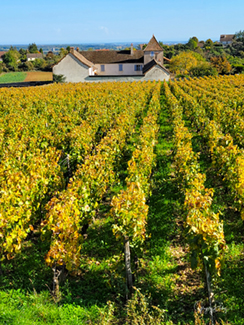
|
-
10/18, Day 9 of tour
-
The owners showed us through the Chateau de Rully. After the tour we tasted three of their wines. The last two were particularly good.
-
The Château de Rully is a castle in the commune of Rully in the Saône-et-Loire département of France. Located on the side of a hill, the castle dominates the whole region, facing the plain leading to the Saône. To the west, it commands the valley towards Nantoux and Chassey-le-Camp.
-
At the end of the 14th century, the castle consisted of a square keep, three round corner towers and one flanking tower. All the elements are connected by curtain walls with a covered round walk, and crenelated at the top. There was a protective broad, deep moat surrounding the base, as well as a single drawbridge, the location of which is still visible on the southern face. In the 15th century, the Saint-Leger family added, on the east, north and west of the interior courtyard, a succession of buildings with splendid oak woodwork, supporting the corbelling of the round walk which was covered with flat Burgundian tiles. At the end of the 19th century, alterations concealed certain aspects of the mediaeval structure. For example, the moat was filled in, the drawbridge and the large, protective, courtyard doors were removed, and a neo-Gothic building with machicolation inside the courtyard at the foot of the keep was constructed.
-
The ground floor rooms of the towers are arched and the bedrooms and the corridors are covered with ceilings with exposed beams and joists. Lava roofed farm buildings, the remainders of the old lower courtyard, surround the large external courtyard and serve as an avenue of honour in front of the gate. The castle is privately owned. It is listed as a monument historique on the supplementary inventory of the French Ministry of Culture.
- Photos of Rully Castle and the environs
|
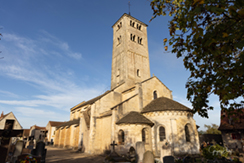
|
-
10/19, Day 10 of tour
-
Chapaize is a commune in the Saône-et-Loire department in the region of Bourgogne-Franche-Comté in eastern France.
-
It features a Romanesque church built in the 11th century, in lombard style, surrounded by stone-built houses with the typical covered galleries of this region with a 16th-century watch tower. In the hamlet of Lancharre, there is a church of the 12th century, remains of a canonnesse's monastery.
-
The Church of St. Martin of Chapaize is the most beautiful building of all the Burgundian village. Old passage on the initiatory path of Saint-Jacques de Compostela, the church building was built in the first half of the eleventh century. Listed building, the church is now one of the oldest Romanesque of Burgundy. It is the only remnant of an ancient priory founded in the tenth century and formerly dependent on the abbey of Saint-Pierre de Chalon. Campanile of over thirty-five meters height does not lack elegance, as its very slender nave. The building has undergone some changes in the sixteenth century, including the opening of a large bay in the western facade, in the early Romanesque style. Inside, one can admire one of the oldest statue columns known in the West.
-
Also dating from the eleventh century, the Castle of Uxelles is installed at the tip of a spur which dominates the surrounding area. Repeatedly altered and damaged the building today consists of a rectangular main building and two wings at right angles. This is unfortunately a private property that can not be visited.
-
Around Chapaize lie a large state and communal forest and two ponds. In the 4 hamlets of Chapaize (Bessuge, Gemaugue, Lancharre and Chapaize), there are several laundrettes which were still used at the beginning of the 1950s.
- Photos of the vllage of Chapaize
|
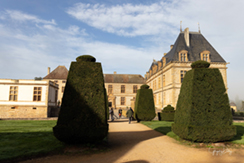
|
-
10/19, Day 10 of tour
-
We visited the Chateau de Cormatin.
-
Du Blé for ever’ (the family motto) Already regarded as ‘noble men’ in 1022, the du Blé became lords of Cormatin in the early thirteenth century.
-
At the end of the sixteenth century, the wars of religion allowed Antoine du Blé to increase his influence and wealth. He became master of southern Burgundy in the name of the Catholic League before ‘turning coat’ and bringing the right bank of the Saone under the authority of Henri IV, in opposition to the Spanish Franche-Comte.
-
In return, he became lieutenant general and governor of Chalon sur Saone, then a strategic stronghold. His son Jacques was received at the Court of France. From 1610 he was an intimate of the Queen Regent Marie de Medici. In 1617, at age 35, he married Claude (aged 13), daughter of Raymond Phélypeaux, Treasurer of the Savings, Secretary of State, one of the most influential men of the moment. In 1618, Jacques du Blé received one of the first titles of Marquis created by the young Louis XIII. In 1628 he was made responsible for conquering the marquisate of Monferrato in Italy. Without money, food or ammunition, his troops were ‘defeated as snow would be melted by fire’ (Richelieu). Humiliated, he tried to regain his honor by a brilliant action. During the siege of Privas, before the king, he launched a daring attack during which he was killed (May 14, 1629). His soldiers avenged his death by a massacre during the capture of the city.
-
Subsequent generations resided very little in Burgundy. But Nicolas du Blé, Marshal of France, governor of Alsace and a member of the Council of Regency on the death of Louis XIV in 1722 was exiled there for his opposition to the alliance with England. His nephew and heir, Henri-Camille de Béringhen, First Equerry to King Louis XV, then left all the marquisate of Huxelles to his natural daughter, Sophie Verne.
-
Burgundian wine saves the chateau! With her, the chateau came back to life in the summer. Her husband, Pierre Dezoteux, aide-de-camp to Rochambeau during the American Revolutionary War, established many specimen trees in the gardens (tulip trees, swamp cypresses). During the ‘Great Fear’ in 1789, he managed to calm the rioters, who aimed to burn the castle, by rolling out all the barrels from the wine cellars for them ... During the Revolution he became head of the Chouans of Brittany, while his wife, remaining in Cormatin with her six children, was not troubled. The chateau came through the storm unscathed. However, in 1815, some dodgy alterations caused the collapse of the south wing.
-
The romances of the poet In 1812, Lamartine seduced the daughter of the owners, Nina Dezoteux, wife of the Count of Pierreclau and a son was born of this dalliance. The poet often returned to the château after 1843, when one of his relatives, Henri de Lacretelle, inherited it. He wrote a significant part of ‘The History of the Girondins’ there, thanks to the family archives. In 1847, he met his political friends in Cormatin to write his republican and socialist programme. Printed in Macon, this text excited interest throughout Europe at the time of the 1848 revolutions. To preserve the memory of the event, a statue representing the Second French Republic was erected in the courtyard in 1849. It has survived but ... decapitated.
-
On July 14 1888, Jacques de Lacretelle was born at the chateau: he was one of the great French writers of the twentieth century (Silbermann). In his series of novels ‘Les Hauts-Ponts‘, he was inspired by the tragedy for his family from the loss of the estate, sold in 1898 to Raoul Gunsbourg. Under this Director of the Monte-Carlo Opera, Cormatin became a summer retreat for the world of entertainment and politics. Each year, the ‘Musical Concours of Cormatin’, chaired by the composer Jules Massenet, heard an operetta or an opera before the facades of the chateau. The performers were prestigious: Caruso, Chaliapine, Litvine, Tamagno, etc.
-
After this brilliant period, more than 50 years of neglect lead Cormatin to the brink of ruin. In September 1980, Anne-Marie Joly, Marc Simonet-Lenglart, and Pierre-Albert Almendros acquired this ‘masterpiece in peril’. Since then they have been dedicated to its restoration and development, with the support of the 60,000 people who visit the chateau each year. From 1982 to 1995, the restoration of the chateau also received financial aid from the Ministry of Culture and the Conseil Général of Saône et Loire for the restoration of facades, the re-excavation of the moat and the renovation of the seventeenth century painted decor.
- Photos of the Chateau de Cormatin
|
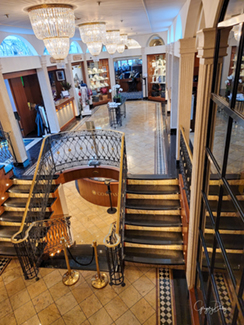
|
-
10/20, Day 11 of tour
-
Rainy day today with overcast skies. We have been so lucky with the weather being clear blue skies and warmer than usual.
-
Meet Mariya Primova, the creative genius behind The Adventures of Little Kali.
-
The gala dinner, last night on the boat, was seven courses with 3 wines. The food was okay. Service was really great. The wines were okay. You would expect better wines and food for the region we are in.
-
Lyon is the third-largest city and second-largest metropolitan area of France. It is located at the confluence of the rivers Rhône and Saône, 243 mi southeast of Paris, 173 mi north of Marseille, and 70 mi southwest of Geneva.
-
The city of Lyon proper had a population of 522,969 in 2019 within its small municipal territory of 19 sq mi, but together with its suburbs and exurbs the Lyon metropolitan area had a population of 2,280,845 that same year, the second most populated in France. Lyon and 58 suburban municipalities have formed since 2015 the Metropolis of Lyon, a directly elected metropolitan authority now in charge of most urban issues, with a population of 1,411,571 in 2019. Lyon is the prefecture of the Auvergne-Rhône-Alpes region and seat of the Departmental Council of Rhône.
-
The capital of the Gauls during the Roman Empire, Lyon is the seat of an archbishopric whose holder bears the title of Primate of the Gauls. Lyon became a major economic hub during the Renaissance. The city is recognized for its cuisine and gastronomy, as well as historical and architectural landmarks; as such, the districts of Old Lyon, the Fourvière hill, the Presqu'île and the slopes of the Croix-Rousse are inscribed on the UNESCO World Heritage List. Lyon was historically an important area for the production and weaving of silk. Lyon played a significant role in the history of cinema since Auguste and Louis Lumière invented the cinematograph there. The city is also known for its light festival, the Fête des Lumières, which begins every 8 December and lasts for four days, earning Lyon the title of "Capital of Lights".
- Photos of Lyon and the environs
|
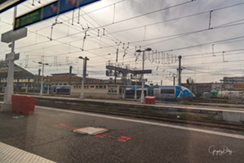
|
-
10/21, Day 12 of tour
-
We had our final briefing on the boat and we departed MS Emerald for a short bus tour of Lyon and the local market to buy lunch for the train. Little Kali was all packed and ready to go.
-
Boarded the TGV train in Lyon for an incredibly fast ride to Paris. The train was very long and of course first class is in the last compartment so walking to and from our seats wore everyone down.
-
The TGV (French: Train à Grande Vitesse, "high-speed train") is France's intercity high-speed rail service, operated by SNCF. SNCF worked on a high-speed rail network from 1966 to 1974 and presented the project to President Georges Pompidou who approved it. Originally designed as turbotrains to be powered by gas turbines, TGV prototypes evolved into electric trains with the 1973 oil crisis. In 1976 the SNCF ordered 87 high-speed trains from Alstom. Following the inaugural service between Paris and Lyon in 1981 on the LGV Sud-Est (LGV for Ligne à Grande Vitesse; "high-speed line"), the network, centered on Paris, has expanded to connect major cities across France (including Marseille, Lille, Bordeaux, Strasbourg, Rennes and Montpellier) and in neighbouring countries on a combination of high-speed and conventional lines. The TGV network in France carries about 110 million passengers a year.
-
The high-speed tracks, maintained by SNCF Réseau, are subject to heavy regulation. Confronted with the fact that train drivers would not be able to see signals along the track-side when trains reach full speed, engineers developed the TVM cab-signalling technology, which would later be exported worldwide. It allows for a train engaging in an emergency braking to request within seconds all following trains to reduce their speed; if a driver does not react within 1.5 km (0.93 mi), the system overrides the controls and reduces the train's speed automatically. The TVM safety mechanism enables TGVs using the same line to depart every three minutes.
-
A TGV test train set the world record for the fastest wheeled train, reaching 357.2 mph on 3 April 2007. Conventional TGV services operate up to 200 mph on the LGV Est, LGV Rhin-Rhône and LGV Méditerranée. In 2007, the world's fastest scheduled rail journey was a start-to-stop average speed of 173.6 mph between the Gare de Champagne-Ardenne and Gare de Lorraine on the LGV Est, not surpassed until the 2013 reported average of 176.3 mph express service on the Shijiazhuang to Zhengzhou segment of China's Shijiazhuang–Wuhan high-speed railway.
-
The TGV system itself extends to neighbouring countries, either directly (Italy, Spain, Belgium, Luxembourg and Germany) or through TGV-derivative networks linking France to Switzerland (Lyria), to Belgium, Germany and the Netherlands (Thalys), as well as to the United Kingdom (Eurostar). Several future lines are planned, including extensions within France and to surrounding countries. Cities such as Tours and Le Mans have become part of a "TGV commuter belt" around Paris; the TGV also serves Charles de Gaulle Airport and Lyon–Saint-Exupéry Airport. A visitor attraction in itself, it stops at Disneyland Paris and in tourist cities such as Avignon and Aix-en-Provence as well.
- Photos of the TGV Train
|
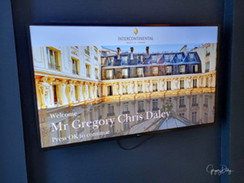
|
-
10/21, Day 12 of tour
-
Tauck uses the Intercontinental Hotel Le Grand which is an incredibly beautiful and historic hotel. The rooms were large and the bathrooms were so functional and well laid out. The bed was comfortable. In short, it was one of the best hotels I have ever used. I would love to return again some day.
-
Le Grand Hôtel was built by the wealthy brothers Isaac and Émile Pereire and designed by Alfred Armand, who had previously designed the nearby Grand Hôtel du Louvre for them. Construction began in April 1861; the hotel was inaugurated on 5 May 1862 by Empress Eugenie, wife of Napoleon III, before officially opening on 30 June 1862. The hotel's construction was part of the complete reconstruction of Paris supervised by Baron Haussmann at the time and it was built in the prescribed style, with a mansard roof. Filling an entire triangular city block, the hotel boasted 800 rooms on four floors for guests, with another whole floor for their servants.
-
The hotel has hosted royalty throughout its long history, including Tsar Nicholas and Tsarina Alexandra, King Edward VII of England and Queen Rania of Jordan. Victor Hugo hosted parties at the Le Grand Hotel and Émile Zola used the hotel for the setting of the death of his tragic character Nana.
-
In 1869, James Gordon Bennett, Jr., who would soon become publisher of the Paris Herald, forerunner of the International Herald Tribune, met with Henry Morton Stanley in the hotel's Imperial Suite to convince him to make his famous journey to Africa in search of David Livingstone.
-
Creditors of the Péreire brothers seized the hotel in 1878, and in 1887, André Million formed Société du Grand Hôtel to manage Le Grand Hotel, along with the nearby Hotel Meurice and later the Hotel Prince de Galles. The Italian CIGA Hotels chain acquired the three hotels in 1972.
-
CIGA sold the hotels in 1978 for $25 million to Limnico, a Liberia-based subsidiary of Roger Tamraz's First Arabian Corporation. Limnico resold the properties for $55 million just a year later, in October 1979, to Maxwell Joseph's UK-based Grand Metropolitan Hotels. Grand Metropolitan acquired the Inter-Continental Hotels chain in 1981, and placed Le Grand Hotel under their management. The hotel was renovated between 1985 and 1990 by noted French designer Pierre-Yves Rochon.
-
In 1986, the hotel was renamed Le Grand Hotel Inter-Continental Paris. The hotel closed in December 2001 for another major renovation. Inter-Continental Hotels was reorganised as InterContinental Hotels Group while the hotel was closed, before it reopened on 5 April 2003, with its name modified slightly, as InterContinental Paris Le Grand Hotel. InterContinental sold the hotel to Qatar-based Constellation Hotels in 2014 for €330 million, although InterContinental continues to manage the property.
- Photos of the Intercontinental Hotel Le Grand
|
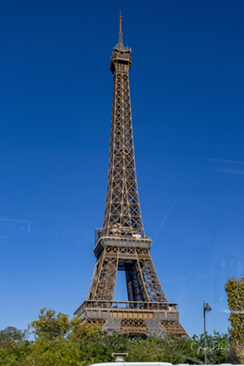
|
-
10/22, Day 12 of tour
-
We had a wonderful bus tour of Paris and saw all the important sights in the town center. I met up with my fraternity brother Michael Kirtley at my hotel.
-
Paris is the capital and most populous city of France, with an estimated population of 2,165,423 residents in 2019 in an area of more than 41 sq mi, making it the 34th most densely populated city in the world in 2020. Since the 17th century, Paris has been one of the world's major centres of finance, diplomacy, commerce, fashion, gastronomy, and science. For its leading role in the arts and sciences, as well as its very early system of street lighting, in the 19th century it became known as "the City of Light". Like London, prior to the Second World War, it was also sometimes called the capital of the world.
-
The City of Paris is the centre of the Île-de-France region, or Paris Region. According to the Economist Intelligence Unit Worldwide Cost of Living Survey, in 2021, Paris was the city with the second-highest cost of living in the world, tied with Singapore, and after Tel Aviv.
-
Paris is a major railway, highway, and air-transport hub served by two international airports: Paris–Charles de Gaulle (the second-busiest airport in Europe) and Paris–Orly. Opened in 1900, the city's subway system, the Paris Métro, serves 5.23 million passengers daily; it is the second-busiest metro system in Europe after the Moscow Metro. Gare du Nord is the 24th-busiest railway station in the world and the busiest located outside Japan, with 262 million passengers in 2015. Paris is especially known for its museums and architectural landmarks: the Louvre received 2.8 million visitors in 2021, despite the long museum closings caused by the COVID-19 virus. The Musée d'Orsay, Musée Marmottan Monet and Musée de l'Orangerie are noted for their collections of French Impressionist art. The Pompidou Centre Musée National d'Art Moderne has the largest collection of modern and contemporary art in Europe and Musée Rodin and Musée Picasso. The historical district along the Seine in the city centre has been classified as a UNESCO World Heritage Site since 1991; popular landmarks there include the Cathedral of Notre Dame de Paris on the Île de la Cité, now closed for renovation after the 15 April 2019 fire. Other popular tourist sites include the Gothic royal chapel of Sainte-Chapelle, also on the Île de la Cité; the Eiffel Tower, constructed for the Paris Universal Exposition of 1889; the Grand Palais and Petit Palais, built for the Paris Universal Exposition of 1900; the Arc de Triomphe on the Champs-Élysées, and the hill of Montmartre with its artistic history and its Basilica of Sacré-Coeur.
- Photos of Paris
|
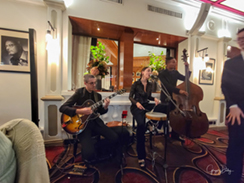
|
-
10/22, Day 13 of the tour
-
Our last evening together was a farewell dinner celebrated at Fouquet's. Needless to say the wines and meal were exquisite. The jazz trio is a Tauck tradition at this event. They were very mellow. Listen to the videos. It was a lovely way to end a perfect trip.
-
Fouquet's Paris is a historic high-end brasserie restaurant in Paris, France. It is located at 99 Avenue des Champs-Élysées and is part of Hotel Barrière Le Fouquet's Paris. The menu, designed in collaboration with Chef Pierre Gagnaire, continues the tradition of classic French cuisine, including Fouquet's beef tartare, sole meunière, Simmental beef fillet with Champs-Elysées sauce.
-
The brasserie is famous for its red awnings on the Champs-Elysées, which spread over the two terrasses on the Champs-Elysées and George V avenues.
-
For decades, Fouquet's Paris has been a place where people from the Culture industry would meet. It has strong ties with the Cinema, and hosts every year the traditional Gala dinner after the César ceremony.
-
The restaurant is listed as a historical French monument since 1990 (Inventaire des Monuments Historiques). The historical decor includes mahogany woodpanelling by Jean Royere, Harcourt portraits of notable actors and actresses, and discreet brass plaques which indicate the favourite tables of famous people. Most frequent guests own their silver napkin rings with their name engraved on it.
-
Although the name of the restaurant's founder, Louis Fouquet, is pronounced in the standard French way, rhyming with "bouquet", the restaurant name is pronounced with a hard "t" and "s", rhyming with the English word "nets".
- Video of the trio playing at Fouquet's (Cry Me a River)
- Video of the trio playing at Fouquet's
- Photos of our Farewell Dinner at Fouquet's
|
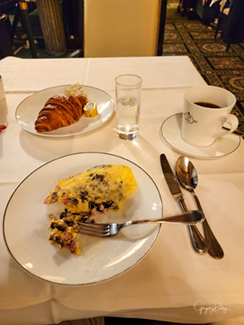
|
-
10/23, Day 14 - Journey Home
-
I had my last breakfast in Paris in my hotel (the Intercontinental Hotel, originally known as the Grand-Hôtel de la Paix in 1862) at the Café de la Paix. Such an elegant way to end such a fabulous trip. The buffet went on forever. It was tempting to try one of everything.
-
The Café de la Paix is a famous café located on the northwest corner of the intersection of the Boulevard des Capucines and the Place de l'Opéra, in the 9th arrondissement of Paris, France. Designed in the Napoleon III style by the architect Alfred Armand, who also designed the historic Grand-Hôtel in which the café is located, its florid interior decorations, historic location, and high-profile clientele have all brought it international recognition as a site of great cultural significance.
-
The Café de la Paix was opened on 30 June 1862 to serve the Grand-Hôtel de la Paix, whose name was later shortened to Le Grand-Hôtel. Both were constructed as part of Haussmann's renovation of Paris, with financing from the wealthy Pereire Brothers. It first gained an international reputation by servicing visitors to the International Exposition of 1867. Its proximity to the Palais Garnier opera attracted many famous regulars including Jules Massenet, Émile Zola, Pyotr Ilyich Tchaikovsky, and Guy de Maupassant. During the Belle Époque, visitors to the café included Sergei Diaghilev, Oscar Wilde, and the Prince of Wales and future King of the United Kingdom, Edward VII.
-
The café quickly became a major cultural phenomenon and tourist attraction, being depicted in numerous forms of media beginning in the late 1800s. It was first used as a site for film screenings in 1896, and continued to attract Hollywood figures like Marlene Dietrich, Yves Montand, and Roman Polanski throughout its life, both as guests and as the crew of films shot onsite. The café is referenced in musical works by Sidney Bechet and Thomas Fersen, and is the subject of numerous impressionist paintings by artists like Konstantin Korovin, Antoine Blanchard, and Édouard Cortès. It is the setting for the poem The Absinthe Drinkers by the Canadian poet Robert Service and a short story My Old Man by Ernest Hemingway. It is also depicted in the Disney film The Aristocats, inserted as a reference by Walt Disney who had visited during his time as a Red Cross ambulance driver in World War I. A radio studio was later installed in the café, which broadcast the 1948 program This Is Paris — the first-ever live broadcast from Paris to the United States.
-
On 1 September 1897 ownership of the café and the Grand-Hôtel were transferred from the Pereires to French hotel magnate Arthur Millon, who leveraged the site to create one of Paris' largest hospitality industry conglomerates. Upon his death in 1913, he bequeathed his hotel empire to his son André. Following disputes over the latter's succession, the conglomerate (including the café itself) was sold in 1972. On 22 August 1975 the café's interior, as well as numerous parts of the hotel which house it, were declared a monument historique by the French government. The Café de la Paix was renovated in 2002 by the Bâtiments de France, a state-run architectural firm specializing in historic preservation.
- Photos of breakast at Café de la Paix
|
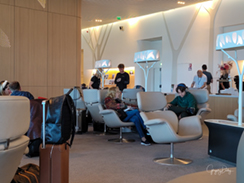
|
-
10/23, Day 14 - The Flights Home
-
Step 1 - depart hotel in Mercedes Benz for Charles de Gaulle airport. The driver, a very nice guy, handles all the bags up to the check in counter. Check my 2 big Pelican cases to Atlanta to clear customs then re-check them to Lafayette.
-
Step 2 - transfer to wheel chair. My driver was another nice guy. Zooms through immigration. Security a bit untrustworthy. I received a five minute massage literally. Must have been my 5.11 clothes.
-
Step 3 - wait in Air France executive lounge. Back to airplane food, which isn't all bad in Paris.
-
Shep 4 - board airplane. Wait for 350p takeoff.
-
Landed in Atlanta and cleared immigration and customs quickly. Re-checked bags for Lafayette. and flew home.
-
David Prejean met me in Lafayette and helped with my bags and gave me a ride home. Thank you David.
-
All in all it was quite an experience. I learned that I needed to work on my endurance before I attempt my next trip. I thoroughly enjoyed all the sites and all the new friends I made over the two week period. It was a bucket list adventure.
- Photos of the flights home
|
